Hi, to access a certain paper please type the paper's full code: eg. mddn242
Don't wanna be here? Send us removal request.
Text
CCDN231 . Project 2 . Experiment . Rationale .
Rebellion is rarely without a cause. When there is a sense of oppression and stagnation, there will be social and cultural tension, which will naturally develop into the desire for change. A burning for truth rather than censorship, for freedom rather than oppression, for equality rather than unjust hierarchies, for humanitarian and cultural interests rather than capitalist and consumerist concerns, for awareness rather than ignorance – these are just some of the passions evoked in people when there is a cause for rebellion.
Rebellion can be expressed a variety of forms. In 1960s America, activists of the black civil rights movements rebelled against racial inequality through different ways. The desire for change was expressed through: dramatic aesthetic projection of image - otherwise known as the “Black is Beautiful” campaign, marches, sit-ins, boycotts, and on occasion aggressive rioting. Also, cultural expressions through singing, drama, rock music, graphic arts, literature, and more recently through the internet, have aided in the strength of activism (Desy, 2005). In more contemporary contexts, the rebellion against cultural oppression has been expressed through creative new forms. Flash mobs, street installation art, space hijacking and critical masses are just some of the playful forms of rebellion that brings cultural diversity into an otherwise generic public space (Wright & Fellow, 2005).
To experiment with how a sensed of rebellion and passion can be evoked, I have changed the sensory experiences of walking. By changing the aesthetics of space, the aural perceptions while walking, as well as what the aesthetics of what they are wearing, the stirrings of passion and rebellion are raised. The sensual alteration that was most compelling was the change in aural perceptions. When listening to the more tumultuous rhythm and beats, people were seen to walk with more fortitude, as if no source of oppression could faze them. In contrast, while listening to dull jingles and commercial catchphrases, people would walk with no sense of passion. Furthermore, while listening to soothing classical music, people would walk in a more sauntering gait, with relaxed and comfortable movements that alluded to no sense of rebellion.
A participant commented that while walking past a car store with no music, he would just observe it, whereas when listening to soothing music, he “imagined what it would be like to drive in the cars”, as he was more relaxed and gave his emotions would allow a sense of aspiration. But when listening to Foo Fighters, he says that “it’s heavy, faced paced, and the lyrics and tone of the song makes me want to break away from that kind of place”.
So changes in behavior and relates closely to the way changes in aural perceptions has a strong influence on mood and physiology. The vibrations of the rhythm in music has been said to influence our kinematic sense, altering heart rate and the electrical impulses of the brain (Schneck, Berger & Roland, 2006).
The influence of aural rhythm has the potential to evoke passionate emotions, causing change in mood. These shifts in mood are often what influences people’s movement through spaces, and so music and rhythm can be used as a catalyst for activism and rebellion, as it compels movement physiologically as well as emotionally.
So by altering the sense of aural perceptions, a sense of wanting to subvert from cultural expectations, or be avant-garde, can be inspired. The dissonance in a tune can create a break from repetitive thought processes and physical music, and this allows the listener to question the space through which they walk. Also, the shared cultural connotations of music prompt listeners to be reminded of certain attitudes, and music that is associated with subversion can remind the listener of subversive ideas and perspectives, which in turn create a sense of rebellion – the sense of stepping beyond established boundaries.
Bibliography
Desy, C. (2005). The Art of Protest: Culture and Activism from the Civil RIghtrs Movements to the Streets of Seattle. Canadian Journal of Sociology Online. Retrieved from http://www.cjsonline.ca/pdf/artofprotest.pdf
Schneck, D., Berger, S., & Rowland, G. (2006). The Music Effect. Philadelphia, USA : Jessica Kingsley Publishers
Wright, L. & Fellow, G. (2005, September). Sublime or subversive: Activist culture in reclaiming public space. Paper presented at Walk21-VI “Everyday Walking Culture”, The 6th International Conference on Walking in the 21st Century, Switzerland. Retrieved from http://www.walk21.com/papers/Zurich%2005%20Wright%20Activist%20culture%20in%20reclaiming%20public%20space.pdf
0 notes
Text
CCDN231 . Project 2 . Experiment . Material experiment . Reflection
So in this experiment a contrast has been created in the variety of worn materials, heightening the sensory influences each style of shoes produces. I explored the way social expectations, cultural associations, physiological aesthetic sensations and psychological self-image, combined with the alteration of the style and material of shoes can influence the way people walk. A sense of expression, activism, and freedom from cultural expectations can be evoked when one is wearing clothing that do not associate with standardizing philosophy of business and uniform. Materials that feel tougher and more durable, both physically allow a sense of strength, as well as having the cultural association of being about going beyond the metaphorical footpath, evoking a sense of going beyond the norm, whereas business shoes put a sense of restraint on the wearer.
0 notes
Text
CCDN231 . Project 2 . Experiment . Material experiment
When participants were asked to wear leather business shoes, one commented that they “feel professional”, and also that the “clean shininess means I don’t want anyone to touch it”, and that “the material is so stiff and shiny, I don’t want to walk anywhere”. One expressed that he feels “judged when wearing business shoes because of the expectation to be professional”, and that when wearing his own shoes he “feels more inclined to walk beyond the workplace”, but with business shoes there is little desire for movement and change.
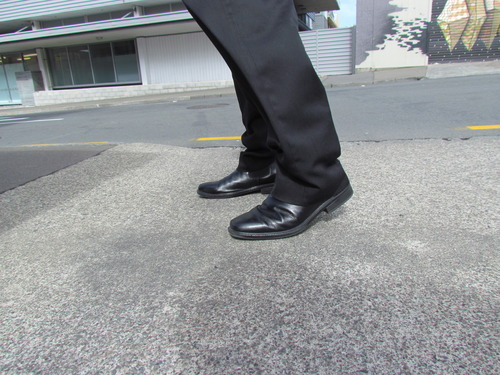
But with the participants were more inclined to move beyond the footpath and explore other forms of terrain, as they “felt stronger”, and “felt like moving around more”. The material of the shoes allowed a greater freedom of movement, and also the slightly more combat boot style of the shoes gave them a sense of restlessness, which creates the desire to move, walk and push boundaries.
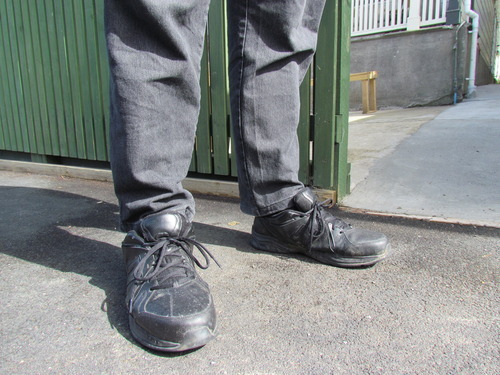
Also, when participants were wearing of their own chosen style, they expressed that they “feel more unique, representing culture”, and that “if I’m wearing my own shoes, I feel more likely to express what I want to”.
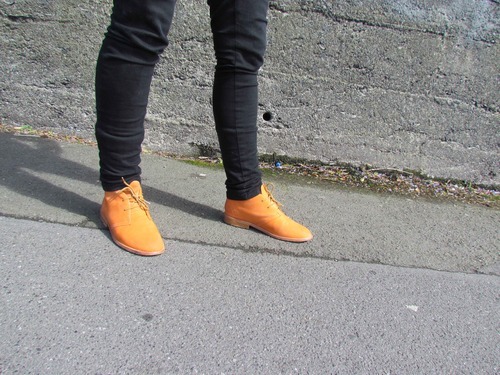
0 notes
Text
CCDN231 . Project 2 . Experiment . Material experiment
What is being worn often has sociocultural, psychological and physiological influences on the wearer. When walking, the aesthetics of shoes, whether it’s visual or textural, can influence the way we walk. Also, the cultural associations with the style of shoes can influence one’s self-image and mood.
In this experiment I will alter the shoes to investigate what styles and materials inspire a sense of movement, passion, freedom and rebellion from preconceived expectations.
0 notes
Text
CCDN231 . Project 2 . Experiment . Environmental experiment . Reflection
So spatial alteration can change the experience of walking and perceiving the space through one is walking, because of the aesthetic and cultural associations of the space. The desire to change the space, or to question the space, can be influenced by the spatial layout, and aesthetics of the space. There are social associations with the feature of the space, such as the railing representing entrapment and control, and posters with tumultuous aesthetics representing cultural expression and therefore the humanist reclaiming of public spaces.
Through bringing participants through a spectrum of contexts with varying spatial elements and aesthetics, the expressive mood of moving beyond the mainstream consumerist construction of street space is created, through artistic, cultural and social expression. By combining the sensory influence of environments spatial and aesthetic elements with material alteration, such as what the participants were wearing, this experiment could have further heightened the emotion of rebellion.
0 notes
Text
CCDN231 . Project 2 . Experiment . Environmental experiment
When moving through a car park, which is a concrete, grey and enclosed area with repetitive features and no cultural expression, participants walked through and expressed “boredom” and “being pressed down”. The way the car park surrounds the participants prompted them to walk through with no sense of energy.

Whereas when walking past Havana Bar, the gentle colours and comfortable, worn aesthetics of the environment attracted gazes, participants commented that they felt “curious” and “relaxed”.
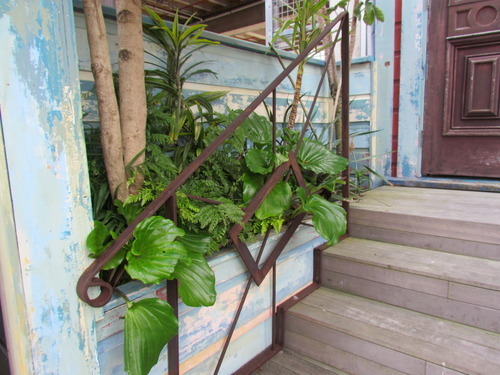
But in the oppressed state of the car park the entrapping space inspired no sense of movement or passion, and in the cosy surroundings of Havana Bar, there was no immediate motive for a sense of rebellion, as the soft aesthetics does not directly elicit a sense of harsh systems that would catalyse the urge for change.
However, in environments that is on the edge of entrapping and repetitive aesthetics, and cultural expression, such as the metal fencing with the wheatpasted tattooed woman beyond it, participants say that walking past they felt more desire to question the metal railing’s representation of authoritative control over public spaces, than when walking through the car park, where there was no sign of cultural expression.
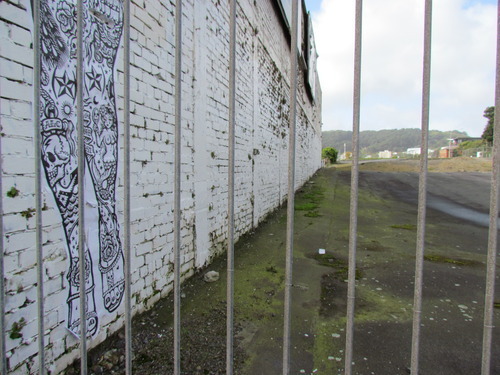
Furthermore, when walking past spaces with freely shared cultural expressions, such as the bus stop with musical artists’ and activists’ posters, participants say they feel more open to changing the space, and to “put my creations up on there”, and also one expressed that she felt that “I’m not being held back at all”. So in environments with artistic and cultural “reclaiming of the streets”, stepping beyond the aesthetics of corporate ideals, the mood of being open to change the space is expressed.

0 notes
Text
CCDN231 . Project 2 . Experiment . Environmental experiment
The environment through which one travels through can influence mood and movement. The spatial and aesthetic characteristics of environments are physiologically evocative and therefore changes the way one relates to it.
0 notes
Text
CCDN231 . Project 2 . Experiment . Aural experiment . Reflection
This experiment could have been further explored by investigating what the participants’ musical tastes and associations with certain kinds of music, as well as experimenting on a wider range of ethnography. The participants had fairly consistent experiences, but that could be due to their shared generational and sociocultural experiences. It would be interesting to see what aural perceptions prompt a sense of the movement, uncertainty and desire for change beyond preexisting systems and surroundings, in an older participant, or a participant with no experience of contemporary music, therefore no memory of its shared cultural associations, and whether the experience would have a similarly heightened arousal of emotions.
0 notes
Text
CCDN231 . Project 2 . Experiment . Aural experiment
When listening to the natural sounds of the city, including the jingles on loudspeakers within stores, one participant expressed that “everywhere you look is products and branding”, while another commented that he “wanted to buy, as the stores forces you to look, but I still feel quite aware”.
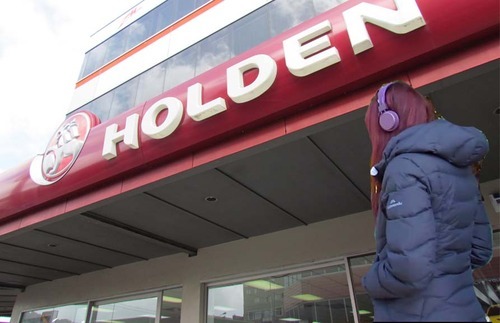
In comparison, while listening to soothing music, a participant suggested that the comforting beat and lyrics of the song put them in a mood to slow down and imagine themselves using the products shown in the shops, as opposed to observing and acknowledging the products. One commented that “the cheerful gentle music of Owl City made me want to stop and imagine myself in the car”, when walking by a Holden dealership.
In contrast, while listening to dissonant and face paced music, they become very aware of the sense of commercialization in the space, and feel evoked to keep moving away from it, instead of lingering around it. One commented that they feel stimulated “to break away from that clean, shiny and produced area”, while another expressed that the beat of the music made them feel the urge to “break the façade of the packaged”.
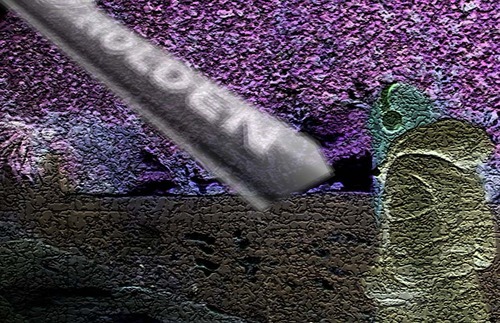
Interesting to note, someone also commented that while listening to music they don’t really feel as if they are part of that space, they feel that “in their own world, or an alternative music video world”, suggesting that with shared aural space heightens the sense of a shared perceptions.
So while individual musical tastes differ, the altering of aural experiences can arouse a range of emotions that changes the way one perceives and moves through their surroundings. The sense of movement beyond established surroundings is evoked by fast paced music, and harmonious tones can bring the listener into sympathy with their surroundings, whereas dissonant tones create a sense of motivation to perceive beyond their surroundings, thus awakening a sense of movement.
0 notes
Text
CCDN231 . Project 2 . Experiment . Aural experiment
The stimulation of the aural perception can change how the listener perceives their surroundings. Whether it’s the healing tones of native American tribal music, the evocative beats of the Maori haka, the stirring dissonant tones of alternative rock music, or the persuasive catch phrases of advertisements, the aural can greatly influence how we perceive this world, as sound can alter our mood physiologically. Also, the aural perception can help us access certain memories, whether it’s individual experiences or cultural associations.
By changing the way commercial contexts are perceived in an urban setting, I will be altering participant’s aural perceptions. By providing a range of aural material, from natural sounds of the city, fast paced dissonant beats of The Boxcar Rattle and Foo Fighters, soothing melodies of Minuit and Owl City, to commercial jingles, I will observe and interview the changes in the experience of walking through urban spaces, and explore the changes in how the environment is perceived with each aural alteration.
0 notes
Text
CCDN231 . Project 2 . Experiment . Introduction
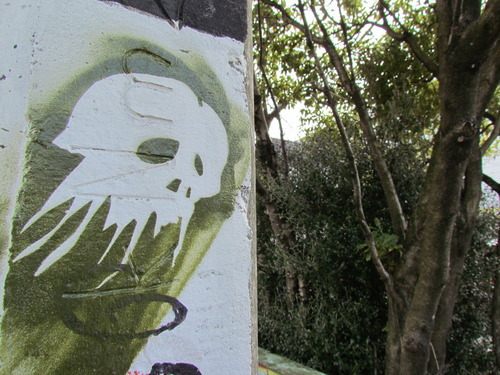
Rebellion. It is the emotion that desires change, a passion burning for movement away from what can be considered by oppression, corruption, ignorance and blind conformity. It can be brought out from a social, cultural, political, infrastructural and environmental awareness that causes questioning in preconceptions of normality and standardisation of beliefs, actions and ways of life.
The contemporary feeling of rebellion often encompasses a playful or satirical expression of culture and diversity, especially in today’s increasingly multicultural and subcultural society.
To inspire the sense of activism and expression, in contrast to the sense of stagnation when there is a lack of variety in perspectives, I will be experimenting with altering people’s aural perception, spatial and visual perception, as well as the aesthetics of worn materials, and considering the sociocultural, psychological and physiological relationship between participants’ experiences and the altering of the perception.
0 notes
Text
CCDN231.Project 1.Auto-ethnography: 3 Sensory Experiences
The experience of the daily routine of wintertime has contrasting sensations, from the sharp breathing brisk morning air, to the soft and blurry warmth of bed.
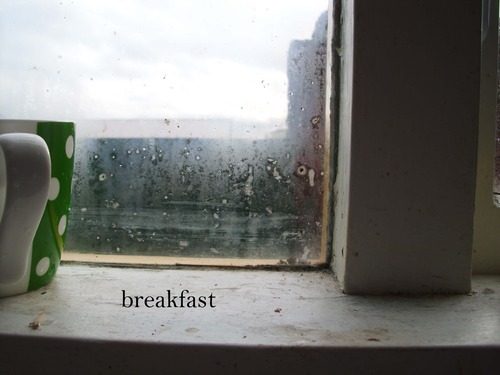
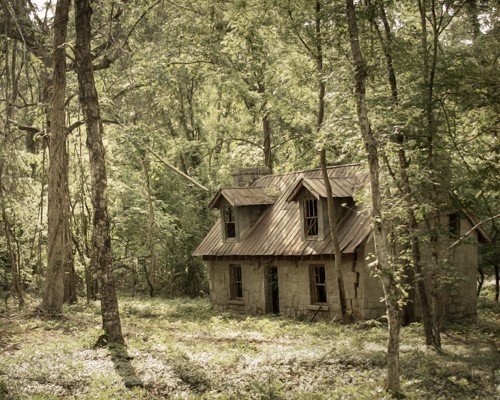
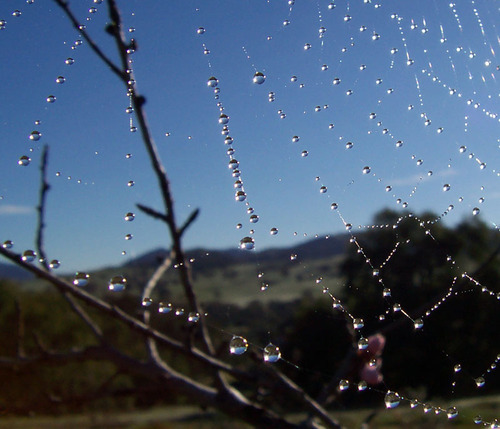
The memory of the sleep still drowsily lingers, and stepping into the soles of my feet feel the kitchens the chill of the tiles permeates my socks. The fear of being late prompts me to quickly and ritualistically grab the bag of oats out of the cabinet. Soft plastic stretches against my fingertips.
Morning sun shines through the window, illuminating the mist and speckles on the glass.
The kettle softly rumbles and clicks itself off, and as I pour the water, steamy warmth rise to my hand. This is quickly contrasted by the cold sloshy milk.
I begin by scoffing the woody oats, but then I taste sweet, warm and milky mix and start chewing slowly and feeling more relaxed. After gulping down the dregs, and the clattering of the bowl in the steel sink is like an chime of an alarm, and I am more awake, feeling filled with oaty energy.
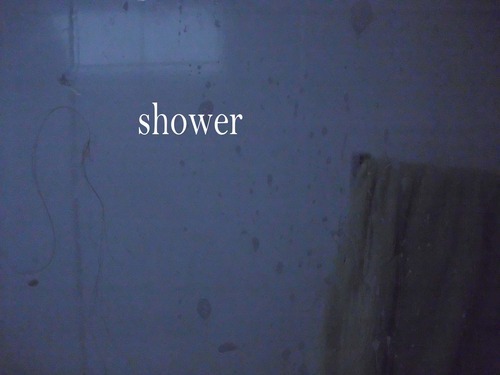
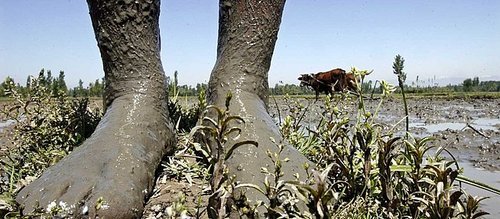
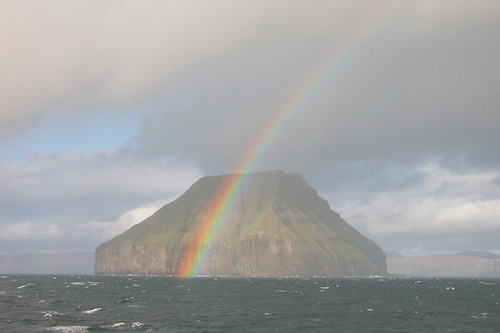
Going into the shower in the wintertime is more a place of warmth rather than the refreshing cool water of summertime. Going in the drowsy and grimy sensations stick to me like a sheen of mucky dust, and the relief of shedding off damp clothes is quickly taken over by the icy cold hitting my skin, and the sound of water hitting the floor is like rain. Quickly the room becomes a cloud, and the feeling of scrubbing the sudsy bubbly soap is cleansing and calming, like a massage. I breath in the scent of vanilla and the cloud becomes sweet and edible.
The shaggy towel embraces me, and the coolness of the morning is momentarily forgotten as the warmth of the shower lingers remains.
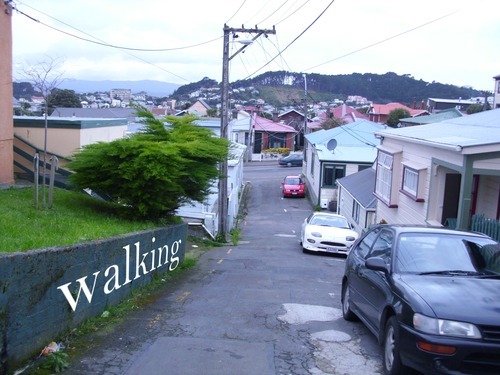

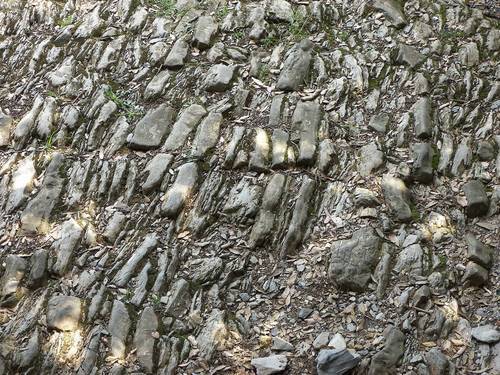
Running downhills in the morning feels like flying. The morning air rushes through my hair, and is fresh as jumping into the ocean. The mossy smell of the footpath makes me feel like I’m in a forest. Then stepping out onto the main road, where the sleepy old people wander and cars rush by, I slow down as if I had just stepped into a hospital. Trudging uphill’s, the to gritty footpath feels familiar like the crunchy gravel of country roads, and I’m anticipating the relaxation of home.
It starts to rain, and the squidging of soggy shoes makes it feel like I’m walking through mud. Also, when it’s raining, space feels more shared as people move to walk in sheltered areas and avoid puddles rather than the open movement of a sunny day. On the bus, the mix of sweet perfume and musty wet clothes permeate the air like a breathable cocktail of flavours. Somber expressions seem to reflect the somber skies, as clouds hang low and gloomy like a basement ceiling.
0 notes
Text
CCDN231.Project 1.Auto-ethnography: Plan
Everyday activities:
~ Eating – breakfast in winter: the feeling of oats in relation to fullness affecting mood, how much in a hurry, how early gotten up, who with.
~Walking – the walk from home to town / uni. Contrast night and day, cold/warm, wet/dry, holiday/hurrying, the texture of the pavement, the neighbourhood (atmosphere of central Riddiford, past the pub, by the hospital etc.
~Showering – the before-sleeping shower, the wake up shower, the after a strenuous activity shower, the cool down or warm up shower.
~Breathing
~Sleeping
CONSIDER:
~Physiological aspects. Eg. Memory and habit, emotional-mental state (eg. the psychology and chemical state of someone's brain, mood, recent interactions), physical state (stamina, height, hungry/full, clean/scruffy, awake/sleepy)
~Contextual aspects: what creates the "vibes" of a place? eg. Transience of seasons, PESTEL, people and cultures, body language, where in time, physical layout of place (i.e. [city, town, country], [developing, underdeveloped, developed], [climate], [physical geography/landscape] etc.)?
EACH AUTO-ETHNOGRAPHY(aka EXPERIENCE):
~Over 3 different days (Monday, Thursday and Saturday)
~Different times of the day
~Different climates
~Different moods (time of the year)
~Always mention a "how this experience could be different" by giving an example of someone else (preferably someone completely different to my "auto-ethnographic" experience e.g. different personal history, different age, different attitude, different dieting and exercising and lifestyle habits), or during a different historical or sociocultural context
0 notes
Text
MDDN242 Project 2: Random+Structure: Final Screenshots of Light Web Icicles
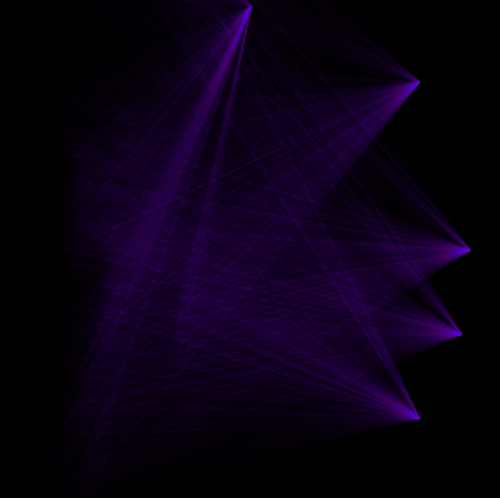
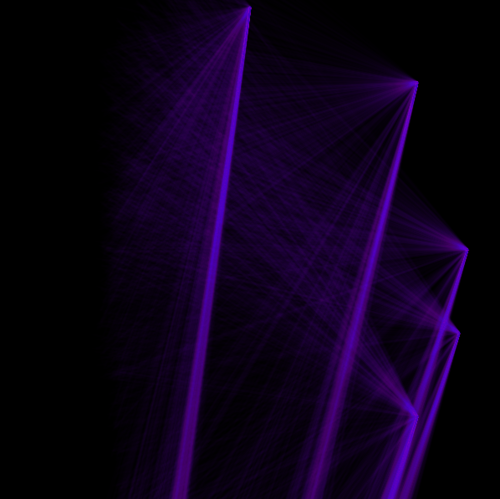
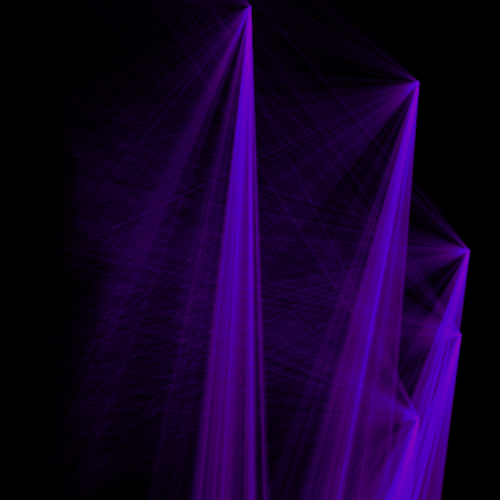
Because of the random, the computer can generate webbed light with an aura that glows and sways.
0 notes
Text
MDDN242 Project 2: Random + Structure: Python
This is the final code:
import math
import random
def rnd11():
return 2. * random.random() - 1
SIZE = 600
xpos = SIZE/4.
ypos = SIZE/5.
def setup():
global xpos, ypos
size(SIZE, SIZE)
smooth()
fill(0,0,0,0)
stroke(104,50,205,2)
strokeWeight(2)
background(0)
def draw():
global xpos, ypos
triangle(xpos, ypos, xpos, ypos, 500, 500)
xpos = xpos +rnd11() * 7
ypos = ypos +rnd11() * 8
triangle(xpos, ypos, xpos, ypos, 550, 400)
xpos = xpos +rnd11() * 2
ypos = ypos +rnd11() * 4
triangle(xpos, ypos, xpos, ypos, 560, 300)
xpos = xpos +rnd11() * 2 * -1
ypos = ypos +rnd11() * 4 * -8
triangle(xpos, ypos, xpos, ypos, 500, 100)
xpos = xpos +rnd11() * 2 * -1
ypos = ypos +rnd11() * 4 * -8
triangle(xpos, ypos, xpos, ypos, 300, 10)
xpos = xpos +rnd11() * -2 * 1
ypos = ypos +rnd11() * -4 * 8
PROCESS:
By setting random to skeletal translucent triangles (not filled and with lowered opacity) to every point of the triangle but one, and by placing the still points in a concave composition, the nature of light is exemplified.
Initially I wanted to create a kind of explosion. But then I arranged the main starting points of the explosion into a concave manner, and reduced the scale of the explosion so there is more structured and distinct points of explosion.
Also, I planned to do a curling reflector instead of a semi-circular reflector, but that is too cluttered, and there would have been a loss of detail as the light layers too much over one another.
Note: The main areas of tweaking in the code have been put into bold font.
0 notes
Text
MDDN242 Project 2: Random + Structure: Precedents
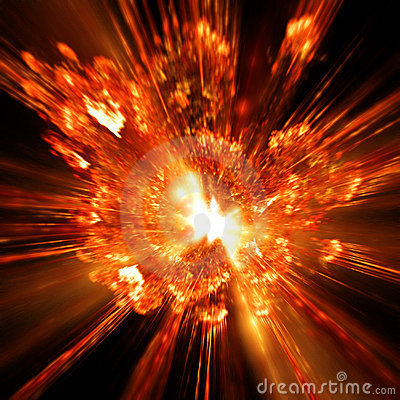
After looking at some of my exercises, I googled "explosion" and saw the above picture, which feels like controlled randomness as it's from one point but could go anywhere depending on the air conditions.
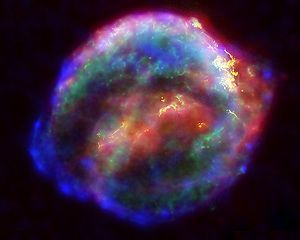
"Explosion" also found this nebula, a further instance of pattern+random in nature.
I may combine the two above precedents, to give something both cloudy and distinct.
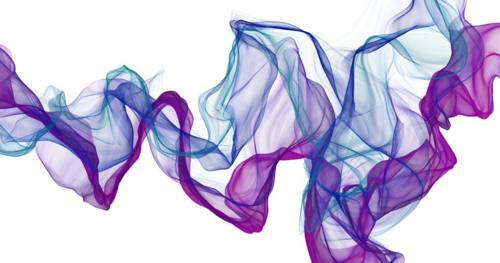
Above is a classic and clear example of generative design, and I will look at this to remain in the mindset of coding.
0 notes
Text
MDDN242 Project 2: Random + Structure: Ideas
The brief outlines the combination of randomness and structure. My idea was to juxtaposing randomness and structure. It was to use regularity and repetition for a still background through the use of mesh images., and random movement for the foreground. I plan to use code that creates repetition with lines, possibly with varying strokeWeight, and also
But after realising that random + structure involves the controlling of randomness, in both visuals and coding, my ideas are inspired by the images above.
0 notes